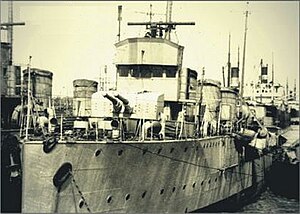Vifor-class destroyer

The Romanian destroyer Mărăști after 1926
|
|
| Class overview | |
|---|---|
| Name: | Vifor class |
| Builders: | Pattison, Naples |
| Operators: | |
| Succeeded by: | Regele Ferdinand class |
| Built: | 1914-1918 |
| In commission: | 1917-1965 |
| Planned: | 12 |
| Completed: | 4 |
| Cancelled: | 8 |
| Retired: | 4 |
| General characteristics | |
| Type: | Destroyer |
| Displacement: |
|
| Length: | 94.7 m (310 ft 8 in) |
| Beam: | 9.5 m (31 ft 2 in) |
| Draught: | 3.6 m (11 ft 10 in) |
| Installed power: |
|
| Propulsion: | 2 shaft Tosi type geared turbines |
| Speed: | 34 knots (63 km/h; 39 mph) (designed) |
| Range: | 1,700 nautical miles (3,100 km; 2,000 mi) at 15 knots (28 km/h; 17 mph) |
| Complement: | 146 |
| Armament: |
|
The Vifor class was a group of four destroyers ordered by Romania in 1913 and built in Italy during the First World War. The four ships were however requisitioned by Italy in 1915 and rearmed as scout cruisers (esploratori), subsequently seeing service in World War I. Two were re-purchased by Romania in 1920 and saw service in World War II. The other two were eventually sold by Italy to the Spanish Nationalists and saw service during the Spanish Civil War.
The four warships were ordered in 1913 by Romania, from the Pattison Shipyard in Naples, with the names Vifor, Viscol, Vârtej and Vijelie. Designed by engineer Luigi Scaglia and based on Romanian specifications, the ships were to be large destroyers armed with three 120 mm guns, four 75 mm guns, five torpedo tubes, and have a 10-hour endurance at full speed, as they were required to operate in the limited perimeter of the Black Sea. However, the four ships were interned on 5 June 1915, soon after Italy joined the war. At that time, one ship was completed 60%, one 50%, one 20% and the fourth was yet to be laid down. They were completed as scout cruisers (esploratori) and commissioned on 27 July 1916, with the names Aquila, Falco, Nibbio and Sparviero. Aquila was the first to be completed, on 8 February 1917, followed by Sparviero on 15 July, Nibbio on 15 May 1918 and Falco on 20 January 1920.
The four vessels were part of a planned class of 12 units, as envisioned by the 1912 Romanian naval program.
Each cruiser measured 94.7 meters in length, with a beam of 9.5 meters and a draught of 3.6 meters. Power plant consisted of Tosi turbines and five Thornycroft boilers, generating a designed output of 40,000 hp powering two shafts, which gave each warship a designed top speed of 34 knots. However, this actually oscillated between 35 and 38 knots, depending on the vessel. Each ship had a complement of 146, with ranges of 1,700 nautical miles at 15 knots and 380 nautical miles at 34 knots. Nibbio and Sparviero were each armed with three 152 mm Armstrong guns and four 76 mm dual-purpose (naval/AA) Ansaldo guns, while Aquila and Falco were each armed with two twin 120 mm guns and two 76 mm Ansaldo guns. Each warship also carried two twin 457 mm torpedo tubes and two 6.5 mm machine guns. Nibbio and Falco could also carry mines, 24 and 38 respectively.
...
Wikipedia
